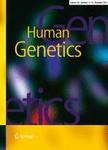版权所有:内蒙古大学图书馆 技术提供:维普资讯• 智图
内蒙古自治区呼和浩特市赛罕区大学西街235号 邮编: 010021

作者机构:Univ Miami Miller Sch Med Dept Psychiat & Behav Sci Miami FL 33136 USA Univ Miami Miller Sch Med Ctr Therapeut Innovat Hussman Inst Human Genom Miami FL 33136 USA Univ Miami Miller Sch Med Dept Human Genet Div Clin & Translat GenetDr John T Macdonald Fdn Miami FL 33136 USA Univ Miami Miller Sch Med Hussman Inst Human Genom Miami FL 33136 USA
出 版 物:《HUMAN GENETICS》 (人类遗传学)
年 卷 期:2014年第133卷第1期
页 面:59-67页
核心收录:
学科分类:0710[理学-生物学] 0303[法学-社会学] 03[法学] 030303[法学-人类学]
基 金:National Institute of Mental Health [5R01MH084880-05]
主 题:GENETIC transcription HUMAN genome FRAGILE X syndrome TREMOR ATAXIA NON-coding RNA GENETIC aspects
摘 要:The majority of the human genome is transcribed but not translated, giving rise to noncoding RNAs (ncRNAs), including long ncRNAs (lncRNAs, 200 nt) that perform a wide range of functions in gene regulation. The Fragile X mental retardation 1 (FMR1) gene is a microsatellite locus that in the general population contains 55 CGG repeats in its 5 -untranslated region. Expansion of this repeat region to a size of 55-200 CGG repeats, known as premutation, is associated with Fragile X tremor and ataxia syndrome (FXTAS). Further expansion beyond 200 CGG repeats, or full mutation, leads to FMR1 gene silencing and results in Fragile X syndrome (FXS). Using a novel technology called Deep-RACE, which combines rapid amplification of cDNA ends (RACE) with next generation sequencing, we systematically interrogated the FMR1 gene locus for the occurrence of novel lncRNAs. We discovered two transcripts, FMR5 and FMR6. FMR5 is a sense lncRNA transcribed upstream of the FMR1 promoter, whereas FMR6 is an antisense transcript overlapping the 3 region of FMR1. FMR5 was expressed in several human brain regions from unaffected individuals and from full and premutation patients. FMR6 was silenced in full mutation and, unexpectedly, in premutation carriers suggesting abnormal transcription and/or chromatin remodeling prior to transition to the full mutation. These lncRNAs may thus be useful as biomarkers, allowing for early detection and therapeutic intervention in FXS and FXTAS. Finally we show that FMR5 and FMR6 are expressed in peripheral blood leukocytes and propose future studies that correlate lncRNA expression with clinical outcomes.